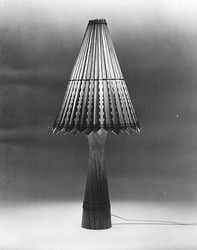Editorial board
This is an apt heading giving a true picture of the first phases of ULUV’s activity, from its foundation in 1945 until consolidation of its orientation in the years 1954 and 1958. The dramatic social situation after the World War II and at the turn of the forties and fifties was also reflected in the management of conservation of folk art production which moved from a phase of statutory protection through attempted subjection to the system of command economy until its final integration in the sphere of cultural products.
In 1945, as one of the first legislative acts in the restored CSR the Presidential Decree No. 110/1945 Coll. was issued, which charged the Centre for Folk Art and Craft Production (UĽUV) – as a public corporation with a nation-wide coverage – with the protection and care of folk arts and crafts, and the sale of its products It had its head office in Prague, its branch office for Slovakia in Bratislava.
The head office in Slovakia organized folk art and craft production in producer and marketing cooperatives as separate operational, legal and economic units. These cooperatives comprised the base of ÚĽUV member cooperatives in Slovakia. In the period 1946 – 1949, the Head Office in Slovakia united around 3 000 folk art producers, mostly home workers, and supported their production and marketed their products. To ensure product sales for these cooperatives, ÚĽUV established a commercial head office, the cooperative Slovakia.
ÚĽUV secured artistic supervision for the cooperatives, overseeing the artistic value of products made and sold by them, helped them organisationally to build up and secured the financial support for the necessary equipment.
Trained artists, ÚĽUV employees, gave advice and ideas to folk art makers and carried out corrections if, in isolated cases, their creative activity deviated from the elements of traditional production or bore signs of kitsch, or if it imitated fashionable foreign patterns. ÚĽUV artists encouraged and developed natural creativity of talented individuals and entire collectives.
Besides organisational, economic and artistic assistance to folk art makers ÚĽUV also engaged in the promotion of folk art and craft production namely through the press, exhibitions and participation in domestic and foreign fairs. ÚĽUV published the journals Tvar/Shape and Věci a lidé/Things and People and an instruction bulletin for ÚĽUV employees and workers in folk art and craft production. It devoted special attention to the survey of the folk art and craft production and its documentation. Over the course of the first seven years of its activity it got hold of valuable study material of remarkable value, which still serves for study purposes not only to UĽUV’s own employees but also to interested people from abroad. ÚĽUV carried out folk costumes documentation the results of which were used particularly by folklore ensembles, theatres and other institutions. Working with competent authorities ÚĽUV addressed the complex price-related, wage-related and social problems of folk art makers paying special attention to the sale of their products.
New conditions – first change
In the early fifties changes occurred in the development and organisation of economic life. The responsibility for the organisation and for folk art and craft operations was transferred to other institutions. ÚĽUV was made part of a research institute for the entire local economy, i.e. also for enterprises not focusing at folk art and craft production. Under the pressures of these changes the folk art and craft production was stagnating; artistic standards of its products went down.
Back to the sector of culture – second change
After unceasing warnings of this untenable situation and keeping in mind that the folk art and craft production was a national cultural asset of remarkable value that could no longer be left to its fate, as of 1 July 1954, the care of the folk art and craft production was transferred to the responsibility of the cultural sector. The decision was made to treat this production as a cultural activity. Attention was to be given, greater than ever before, to the potentialities of individual work, artistic growth, and the protection of creative capacities of folk art makers.
Selective organisation – third change
The state budget support was to go only those makers who demonstrated their qualification and a genuine artistic value of their products. The organisation of folk art and craft production became selective. The products by folk art makers began to be placed on the market under the trademark of ÚĽUV as an art quality label. In December 1954, ÚĽUV opened its first store in Bratislava which simultaneously served as a permanent exhibition of folk art and crafts.
ÚĽUV in Slovakia set up the following special units: the research and documentation department (headed by Ema Marková), the art and design-development department (headed by Václav Kautman), the publishing and marketing department (headed by František Kalesný), the production department (headed by Anna Májeková), and the sales department (headed by František Jesenský).
Consolidation
After the publication of the Act of the Slovak National Council No. 4/1958 Coll. on the folk art production and handicraft the President’s Decree, of 1945, was repealed. The new legal regulation had completed the gradual consolidation of the UĽUV’s activity. Although the questions of further existence of UĽUV were raised in certain periods of subsequent decades, the best answer to the doubts were and still are the results of its activity in all areas or in all its special units.
